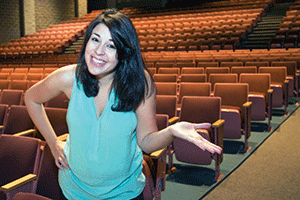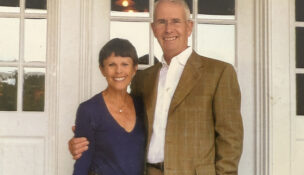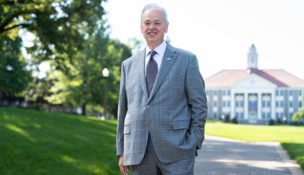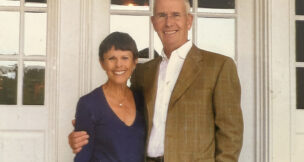Weighing the payoff
Salary data raise new questions in choosing a college
Weighing the payoff
Salary data raise new questions in choosing a college
Carly Maalouf took her mother’s advice to pursue
a career in an area she really cares about.
She holds a master’s degree in education and
a bachelor’s degree in theater from the
University of Mary Washington.
Earning a college degree is a big accomplishment, but so is paying for it. For many graduates, the income they earn their first year out of school is a key factor in paying off college loans and launching their careers.
Now there is new information to help them plan. The State Council of Higher Education for Virginia has produced data that show which degrees and which schools produce the highest incomes for recent college graduates.The figures have a lot of qualifiers, but the data at least gives parents and high school seniors a better picture of what to expect after graduation.
For example, George Mason University tops the list of average first-year annual salary for graduates with four-year bachelor’s degrees at $41,153, according to data from SCHEV and College Measures. (The average is based on income 18 months after graduation for graduates from academic years 2005-06 through 2009-10.) Next is the University of Virginia at $39,648 and then Virginia Tech at $38,957. SCHEV matches unemployment insurance information from the Virginia Employment Commission (VEC) to college graduates, so the salary data include only those graduates who work for employers reporting to the VEC. U.S. government employees, entrepreneurs and graduates working out of state, for example, are not included.
Peter Stearns, provost at George Mason University in Fairfax, says the SCHEV report is good news. But, he adds, “We use it carefully. It’s a snapshot” of a limited group of students in a limited scope of jobs. “This is a new kind of measurement,” Stearns says. Earnings the first year after graduation are only one measure, and there’s a lot that isn’t reflected, he says. “It doesn’t show job satisfaction, and it doesn’t show what you’ll be doing 10 years from now.”
There are plenty of disclaimers attached to the SCHEV data, with good reason. Women, for example, earn less than men, 25 percent less on average. What graduates earn depends on what they study and where they work after graduation. A GMU graduate who lands a job in Northern Virginia is likely to be paid more than someone working in other parts of the state where the cost of living is lower.
More education, better pay
No matter what your career, however, more education typically means better wages. Elementary or middle school teachers with bachelor’s degrees, for example, make $1.8 million over a lifetime of working, while those with master’s degrees average $2.2 million, according to SCHEV.
Stearns says that the number of students pursuing high-earnings-potential areas of study, such as science and engineering, shows “that the message of employability has spread.” Students are drawn to higher-paying degrees, and colleges that offer those degrees are benefiting. “We’re happy to have those students, but we’re delighted to have the liberal arts students, too.”
Other schools feel the same way, pointing out that, while liberal arts degrees might not guarantee the highest-paying jobs the first year out of school, they are still a major reason why students choose a particular college. It’s not always about the money.
Nancy Gray, president of Hollins University in Roanoke, a private women’s college with 749 undergraduate students, says that a student’s earning potential is a factor, “but it’s very important not to stop there. We’re educating and preparing students for jobs — many of which don’t exist yet with technologies that haven’t been invented. You can’t be too job-focused in education because change is taking place so rapidly.”
Gray says today’s students must be “educated not just for a first job, but for a series of jobs.” And what one earns now is not necessarily an indication for future earnings. “An RN makes a good salary the year she comes out, but the income growth after that might not increase too much. A history major can go into the Peace Corps for a year and return and run a museum or go to law school,” she says. “Graduates of liberal arts programs know how to learn.”
Plus, they bring a passion for their course of study. Carly Maalouf of Alexandria graduated from high school five years ago with a desire to study theater and work with children. She took her mother’s advice — pursue a career that you really care about — and graduated this May from the University of Mary Washington with a master’s in education. She already had earned a bachelor’s in theater from Mary Washington the year before and now has begun a yearlong apprenticeship program in theater education at Imagination Stage, a children’s theater program in Bethesda, Md. “I knew that going into teaching or theater meant I wouldn’t make a lot of money, but I love seeing that moment when an idea clicks for a child,” she says. “To me, that’s the cool thing.”
Community college option
When it comes to getting a return on investment, Virginia’s community colleges also offer a good deal. During the five-year period ending in 2010, for example, graduates from the Northern Virginia Community College with a two-year technical/occupational certificate averaged more than $46,000 annually, according to SCHEV data. The price of tuition and mandatory fees at community colleges are only about 38 percent of the average comparable tuition and fees at the state’s public four-year institutions.
Community colleges in Virginia also offer a path to a four-year degree. Students who maintain a good grade-point average for two years at a community college are guaranteed admission to more than 30 public and private colleges and universities in the state, says Jeffrey Kraus, assistant vice chancellor for public relations at Virginia’s Community Colleges. California has similar plan; there may be fine distinctions, but Virginia is the only state with such a comprehensive guaranteed admission program.
“Taking two years of classes at a community college makes it not as big of a financial gamble,” he says. “During the recession, a lot of families turned to community colleges because we provided a good avenue for those who didn’t want to delay or deny their college dreams.”
For students who aren’t sure what career path they want to pursue, meeting their general education requirements at a community college might make even more sense. “There’s not a great deal of difference between English 101 or American History at a community college or another school,” he says.
Gray, the president of Hollins, argues for the value of liberal arts. She notes that the current U.S. poet laureate, Natasha Trethewey, is a Hollins graduate and one of four alumnae who have won a Pulitzer Prize over the years.
“I don’t know what they made the year after they graduated, but I suspect it wasn’t much,” Gray says. “Using earnings potential as a lens is wrong. We cannot become a country of [just] nurses, engineers and accountants. We have to have teachers, poets and musicians. We need people who are willing to go into public service. And we need entrepreneurs with the next big idea.”
P


















